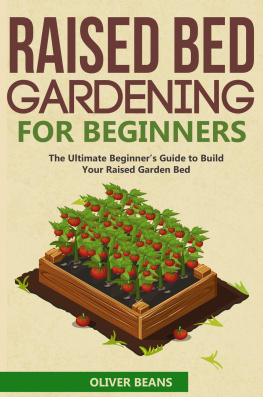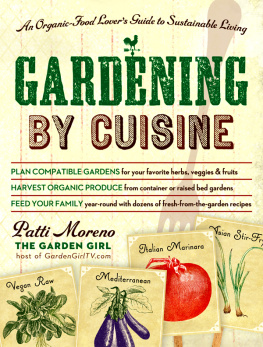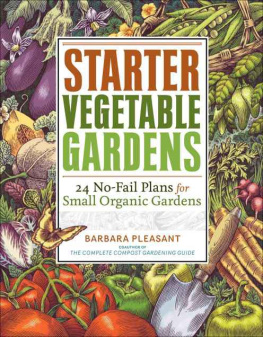GARDENING
BY CUISINE

An Organic-Food Lovers Guide to Sustainable Living
GARDENING
BY CUISINE
Patti Moreno
THE GARDEN GIRL


STERLING and the distinctive Sterling logo are registered trademarks of Sterling Publishing Co., Inc.
2013 by Patti Moreno
Images: Sydney Janey/SJ Design; Dover Publications, Inc.; iStockphoto; Pepin Press; Shutterstock
All rights reserved. No part of this publication may be reproduced, stored in a retrieval system, or transmitted, in any form or by any means, electronic, mechanical, photocopying, recording, or otherwise, without prior written permission from the publisher.
ISBN 978-1-4027-9643-2
For information about custom editions, special sales, and premium and corporate purchases, please contact Sterling Special Sales at 800-805-5489 or specialsales@sterlingpublishing.com.
Book Design and Production: gonzalez defino, ny / gonzalezdefino.com
2 4 6 8 10 9 7 5 3 1
www.sterlingpublishing.com
This book is dedicated to my family for their love and support, and for eating all their veggies.

It all began in a garden
How did I get into growing my own food? It started 70 pounds ago. Thats how much I gained during my pregnancy in the 1990s. I was desperate to feel like myself again, and thats what led me into the garden.

I am probably the least likely person to become a gardening and sustainable-living expert. I was raised in the concrete jungle of New York City in the 1970s and 1980s. I was clueless about plants and natureId never even owned a pet. Unlike the generations before methe baby boomers whose parents and grandparents had planted Victory Gardens to win the warI had no tangible connection to food. As a Generation Xer, my memories of childhood meals go back to eateries like Mickey Ds and classic, packaged comfort food like Stouffers Mac and Cheese.


After graduating, I married my college sweetheart, and we soon moved into our first house, a humble multi-level brownstone in Roxbury, Massachusetts. I remember telling my husband, after we saw the for sale sign, If it has floors, lets buy it! Well, it did have floors, and so we bought it. The house also came with a 4,000-square-foot lot. I remember looking at it, with its five-foot-tall city weeds, and feeling proud that we were landowners! I didnt know anything about gardening, but I knew Id need a shovel and started digging. Before long I discovered what many urban gardeners soon find out: the stuff I thought was soil in my city lot was really bricks, stones, and broken glass. I could shovel only an inch down before a jarring shock blocked my way. I began to sort everything I found, including stacks of whole bricks and partial bricks, brownstone, pudding stone, and all manner of urban rubble.

At that point, my gardening experience consisted of learning how to use a pickax and digging, which also gave me a great full-body workout. Slowly, the pounds began to disappear.

My horticultural breakthrough came about when I managed not to kill a set of dwarf apple trees. They survived the winter and suddenly started blossoming early the following spring. Low and behold, that summer I had fruit! The trees produced wonderful apples and plums, which I shared eagerly with everyoneand they were a big hit. It was a complete eureka moment for me: I can take this tiny urban lot and grow my own delicious, organic food?! From then on I was hooked.

For the next decade, I continued to evolve as a gardener, as I built on each success and began experimenting with different gardening techniques. In a new home, in the same neighborhood, but with much more land, I was able to take my vegetable gardening experiments to the next level and put everything Id learned to the ultimate test: feeding my family produce that came only from the backyard for an entire growing season. I videotaped the whole process, made the videos available online, and produced a DVD series to share what Id learned and to inspire people to live more sustainably.

Since 70 percent of the worlds population will be living in cities within the next twenty years, according to the Population Reference Bureau, it is crucial that we all make it a priority to live sustainably in our everyday lives. Anyone can get started on the road to sustainable living by using organic methods to manage waste control and other natural processes, by conserving energy, recycling, planting trees, and creating more natural landscapes. Last but not least, living sustainably means eating locally grown food. One of the best ways to do that is to garden by cuisine. If enough of us can grow a portion of our own food (including the ingredients to enjoy the cuisines we love best), this effort will have a real effect, not only on the health and well-being of our families, but also on our neighborhoods, communities, and the world.
In Gardening by Cuisine, I want to bring my garden to you, to let you twist juicy tomatoes off the vine and serve them at your dinner table. If you are new to gardening for the kitchen table, youll find great projects here, including step-by-step instructions. You may get your fingernails dirty, but youll also get plenty of tasty kitchen treats for your family to enjoy in no time. If youve been growing your own food for years and want to learn a few tricks to save time and energyso that youll actually have the time to enjoy your gardenthis book is for you too.

COMPANION VIDEOS
Still have questions?
Visit my website at for a chapter by chapter list of videos.) In them I explain some of the trickier parts of home gardening, with the help of my gardening-expert friends (including my daughter).
Part I covers the basics of cuisine gardening. Growing your own food isnt rocket science, and you dont need a degree in botany to grow healthy organic vegetables for pennies. Here, youll learn all about building raised beds, where youll be growing your food, including plans for building a 4x4 raised bed and 4x8 raised bed. To maximize the space you have, you may want to build a hoop house and a trellis, as well as other add-ons for your raised bed.

In Part II, youll find plans for cuisine gardens, growing instructions, and recipes to take you through the entire growing season. Youll enjoy traditional dishes from around the worldincluding Italy, Asia, the Americas, and the Caribbeanall with a fresh, contemporary twist. Each raised bed, however, can give you so much more than just one meal. As your vegetables grow, youll be able to use them individually, or combined with other veggies, to provide an assortment of classic, fresh, and organic dishes for your family. Ill also show you how to use traditional varieties of vegetables that grow well in small spaces (and taste delicious). In short, youll learn everything you need to know to make growing your own food a reality. You
Next page

![Dowding - The Year-Round Vegetable Gardener’s Bible [7 Books in 1]](/uploads/posts/book/453239/thumbs/dowding-the-year-round-vegetable-gardener-s.jpg)













